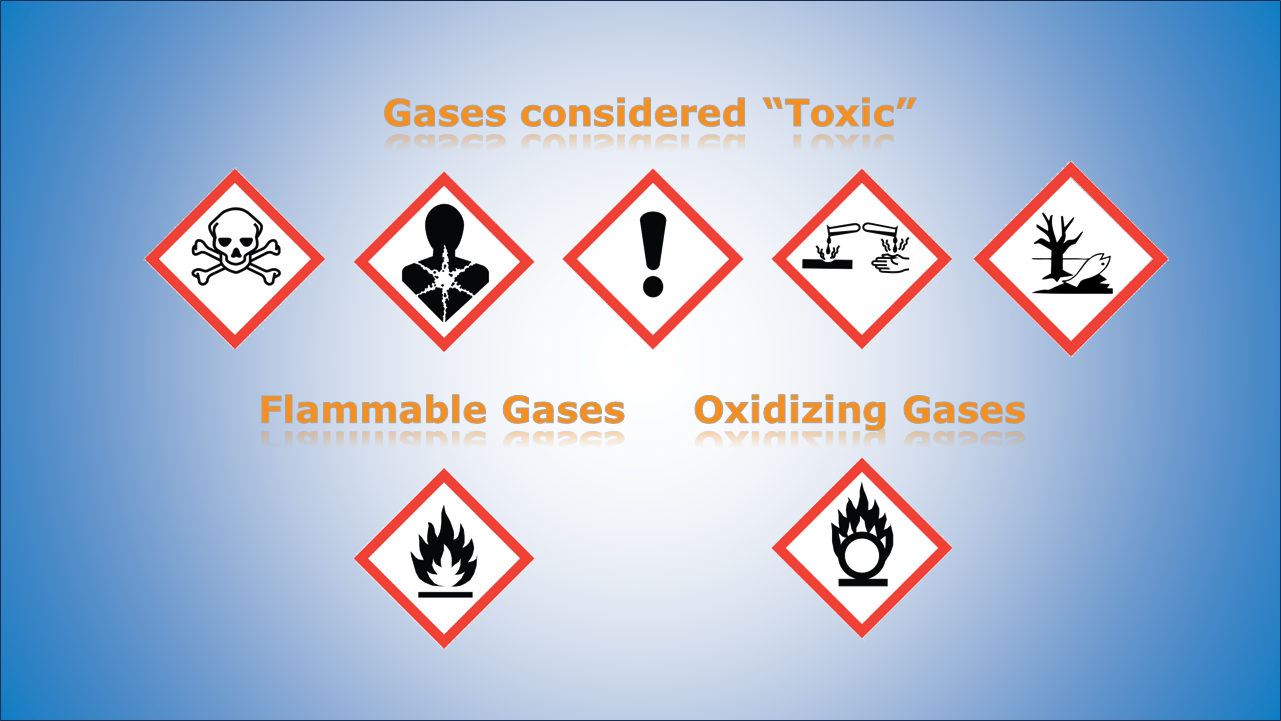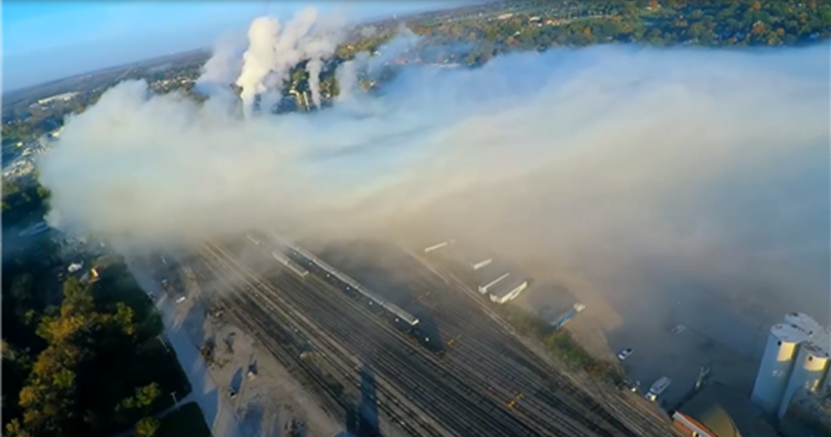“Jumpin’ Jack Flash, it’s a gas.” — Mick Jagger and Keith Richards, of The Rolling Stones
Ever notice how the popular media never refer to chemicals. No, they talk about “toxic chemicals.” It’s as though any material that is not toxic is not a chemical, or perhaps, any material called a chemical must be toxic.
It’s habitual. A release of methane, which is hazardous because of its flammability, is referred to as causing “methane poisoning.” This, despite the fact that methane is non-toxic.
Non-toxic, however, does not mean harmless. As it happens, all gases are hazardous. They exhibit one or more of four hazards:
- Asphyxiation
- Toxicity
- Flammability
- Oxidizing
Asphyxiation
Simple asphyxiation results when we breathe an atmosphere that is oxygen-deficient. Simple asphyxiants are non-toxic gases that kill by displacing oxygen. They include inert gases, like the noble gases (helium, neon, argon, krypton, xenon, and radon) and nitrogen. Some reactive but non-toxic gases, like hydrogen, methane, and propane, are also simple asphyxiants. For the inert gases, the concern is not that workers can be exposed to too much of them, but that the concentration is not so high as to result in an oxygen-deficient atmosphere. Any time the concentration of a gas reaches 6.7% in air, the concentration of oxygen will be decreased to less than 19.5%, the lower permissible limit established by OSHA.
Toxicity
Another hazard of gases is toxicity. Toxic gases actively interfere with essential bodily functions, usually at concentrations well below those that would result in an oxygen‑deficient atmosphere. Carbon monoxide, which has a normal concentration in the atmosphere of about 0.1 ppm, is fatal in just a few minutes at a concentration of 10,000 ppm (1%). An atmosphere containing 1% CO and 99% air will have an oxygen concentration of 20.7%, which is well within OSHA’s safe limits for oxygen concentration. Yet OSHA’s permissible exposure limit (PEL) for CO is 50 ppm.
Gases that interfere with respiration—getting oxygen from the lungs into the blood, and then from the blood into cells—are called chemical asphyxiants or toxic asphyxiants. Gases that interfere with other functions of the body are just called toxic gases.
Flammability
Category 1 flammable gases meet at least one of two flammability criteria. Either they have a Lower Explosive Limit (LEL) equal to or less than 13%, or the range from Upper Explosive Limit (UEL) down to LEL is equal to or greater than 12%. Or both. Category 2 flammable gases can burn in air but meet neither of the flammability criteria. Ammonia, for instance, with an LEL of 16% and a UEL of 25%, is a Category 2 flammable gas.
When a gas is both flammable and toxic, its toxicity will always be at a much lower concentration, so its exposure limits will be based on its toxicity. Hydrogen cyanide burns quite readily. Its flammable limits are 5.6% to 40.0%, which makes it a Category 1 flammable gas by either criterion. Nonetheless, we usually think about HCN in terms of its toxicity, rather than its flammability. The concentration of HCN that is immediately dangerous to life and health (IDLH) is 50 ppm. OSHA has set the PEL for HCN at 10 ppm.
The U.S. National Institute for Occupational Safety and Health (NIOSH) sets the IDLH for a flammable gas to 1/10th of its LEL, thus providing a safety margin. Propane, for instance, has an LEL of 2.1%; NIOSH has set the IDLH for propane at 0.21% (2100 ppm). The OSHA PEL for propane is 1,000 ppm, a further margin of safety.
Oxidizing
Oxidizers are not flammable, but they promote combustion of materials that are. Oxygen is the only gas that is an oxidizer, but is not a simple asphyxiant, not toxic in the normal sense, and is not flammable. There are other oxidizing gases, e.g., nitrous oxide and chlorine, but they are also toxic, which is how we typically characterize them.
No Gas Is Harmless
Some gases are toxic, and their exposure limits are based on their toxicity. NIOSH determines the IDLH, and it is OSHA’s prerogative to set the PEL. NIOSH and OSHA have not set limits for all toxic gases, but for those with limits, the limits are typically expressed in ppm.
Some gases are flammable, and their exposure limits are based on their LEL. Barring toxicity issues, NIOSH sets the IDLH of a flammable gas as 1/10th of its LEL.
Some gases are both flammable and toxic. Invariably, the toxic concentration is much, much lower than the LEL. So, limits, when they are determined, are based on toxicity.
A few toxic gases are also oxidizers. Again, limits, when they are determined, are based on toxicity.
And finally, there are gases that are not toxic, not flammable, and not oxidizers. They are also not air, which makes them simple asphyxiants.
All gases are hazardous.
There Aren’t Many Gases
Bluefield has compiled a list of 146 gases and their hazardous properties. About a third of them are synthetic halocarbon refrigerants that aren’t well characterized. By gas, we mean any material with a boiling point of 25 C (78°F) or lower. It is probably not exhaustive, but it is as complete as we could make it.
The list includes 44 toxic gases, of which eight are also oxidizers. By toxic, we mean any gas that warrants the GHS pictograms for toxic, health hazard, harmful, corrosive, or environmental hazard. Because they are toxic, they are harmful at concentrations well below that of simple asphyxiants.
The list includes 41 flammable gases: 19 flammable gases for which there is a reported LEL and another 22 flammable refrigerants for which there is no reported LEL. They’re not only flammable; they are also simple asphyxiants. They are not toxic.
The list includes another 34 toxic gases that are also flammable.

The list includes 33 gases that are neither flammable nor toxic but are not air—simple asphyxiants.
Finally, the list includes oxygen.
A Hazard Analysis Should Consider the Hazards of Any Gas
The use of the word, “toxic”, is overdone in the popular media, and we are right to scoff when we see it. But just because a gas is not toxic does not mean it is harmless. All gases are hazardous. Any time a gas is used, it should be flagged as a hazard. Depending on whether it is toxic, flammable, or a simple asphyxiant, treat it accordingly.
As for Jumpin’ Jack Flash, which is not on our list: at the very least, it’s a simple asphyxiant.

Very important topic! I work with hazardous area classifications and audits, and, unfortunately, these characteristics are frequently overlooked. As consequence, many companies are at risk, because their area classification plans are not reliable!